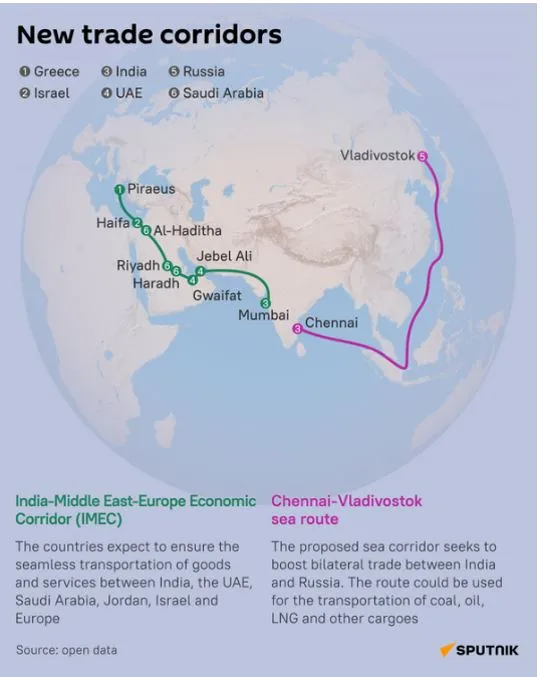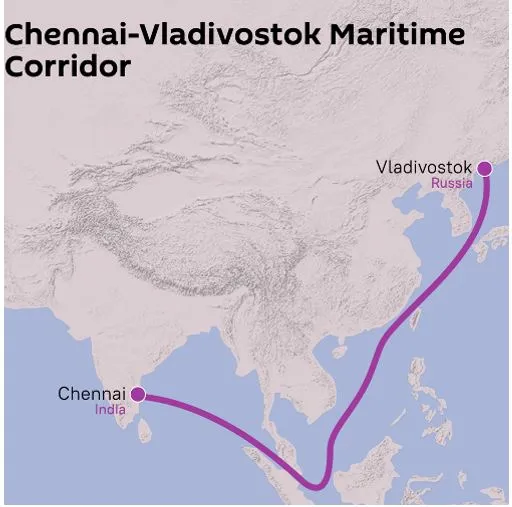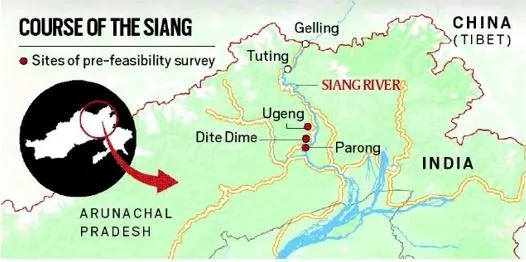

11th July 2024 (8 Topics)
Mains Issues
Prime Minister Modi announced the commencement of the Chennai-Vladivostok Eastern Maritime Corridor during a community program in Moscow, Russia.
About the Project
- The Chennai-Vladivostok Maritime route connects Chennai on India’s east coast with Vladivostok, Russia’s eastern port city, opening a plethora of opportunities for trade and investment for both countries.
- Vladivostok is the end point of the Trans-Siberian Railway, the fourth in terms of cargo turnover, and the first free seaport of the Far East.
- The Vladivostok-Chennai route passes through the Sea of Japan past the Korean peninsula, Taiwan and the Philippines in the South China Sea, past Singapore and through the Strait of Malacca, to emerge into the Bay of Bengaland then cuts across through the Andaman and Nicobar archipelago to Chennai.
- This sea route covers a distance of approximately 5,647 nautical miles or about 10,500 km

Need of new route (to improve connectivity):
- Lack of connectivity is one of the reasons for limited trade between India and Russia, which has for the past few years hovered around the US $12-13 billion level.
- At present, the two countries are linked through the traditional European route which passes through Red Sea, Mediterranean Sea and Baltic Sea.
- Operationalised in 2000, the circuitous route spans from the Nhava Sheva Portin Mumbai to the Port of St. Petersburg in Russia and goods take an average of 40 days to cover the distance of 8,675 nautical miles or about 16,000 km.
Significance
- Shorter route: The Chennai-Vladivostok corridor is a shorter alternative to the current Mumbai-St. Petersburg sea route, reducing shipping distances to about 5,400 km and transport time to approximately 24 days.
Fact Box: Far East
|
- Ideal gateway: The strategic location of Chennai Port on the Bay of Bengal makes it an ideal gateway for trade with Southeast Asian countries like Thailand, Vietnam, and Indonesia.
- Key commodities such as crude oil, coal, LPG, and various goods are expected to benefit from faster transportation.
- Better trade: The trade route promises to enhance trade not only between India and Russia but also with countries like Singapore, Thailand, Vietnam, Malaysia, and Indonesia.
- Immense opportunities:The Port of Vladivostok in Russia provides access to the resource-rich Far East region, offering immense opportunities for Indian businesses to tap into the market sectors like energy, mining, and technology.
- Economic Impact:
- The corridor is set to boost Chennai's economic prominence by increasing cargo traffic with Southeast Asian nations and potentially reaching landlocked Mongolia.
- It positions Chennai to become a robust economic hub similar to Mumbai.
- Russia aims to double its current trade volume with India through the Vladivostok port, currently at 150 million tonnes.
Fact Box: International North-South Transport Corridor (INSTC)
|


Mains Issues
Context
The Supreme Court held as legally maintainable the suit moved by the West Bengal government against the central government's directive allowing the Central Bureau of Investigation or CBI to conduct investigations within the state's jurisdiction.
Background
- The West Bengal government has filed an original suit in the apex court against the Centre under Article 131 of the Constitution, alleging that the CBI has been filing FIRs and proceeding with investigations despite the state having withdrawn the general consent to the federal agency to probe cases within its territorial jurisdiction.
- Article 131 deals with the Supreme Court's original jurisdiction in a dispute between the Centre and one or more states.
Can States bar CBI from functioning in their territory?
- The CBI is a national agency empowered with police authority. Its operational jurisdiction is primarily Delhi and Union Territories.
- Consent Requirement: The Delhi Special Police Establishment Act governs the CBI, mandating state government consent for investigations within their territories.
- Scope of CBI's Jurisdiction:
- Central Government Consent: The CBI investigates cases of national importance or those requiring specialized expertise beyond state police capabilities. Permission from the central government is necessary to conduct investigations within a state.
- Court Directives: Courts can instruct the CBI to investigate specific offenses or incidents within state boundaries, especially in cases involving corruption, impartiality concerns, or serious crimes.
- Cases Involving Central Government Personnel: The CBI has jurisdiction over offenses committed by central government employees or those associated with central government entities nationwide.
- Inter-State and International Cases: The CBI handles cases spanning state borders or with international implications, such as organized crime or economic offenses referred by other states or international agencies.
- State Cooperation: Effective investigation often requires collaboration with state police and local authorities, despite central government permissions or court orders.
In essence, while the CBI can investigate within a state's jurisdiction under specific circumstances outlined by law, its actions typically require consent from the central government or court directives to proceed.


Mains Issues
Context
Textile waste poses a pressing global challenge, with only 12% of textiles recycled worldwide. Merely 1% of discarded clothes are recycled into new garments, with the rest often repurposed into low-value items like insulation or mattress stuffing.
The dark side of fast fashion (Impact)
Despite affordability, fast fashion has significant environmental and social repercussions:
- Environmental Impact: The fast fashion sector contributes 2-8% of global carbon emissions and 9% of annual microfiber pollution in oceans, as per the UN Environment Programme.
- Resource Intensive: It consumes approximately 215 trillion liters of water annually, equivalent to 86 million Olympic-sized swimming pools.
- Social Issues: Workers often endure exploitative conditions for minimal wages, while shareholders profit extensively.
- Greenhouse Gas Emissions: Every phase of the fast fashion lifecycle—from resource extraction and manufacturing to transportation and waste management—contributes to greenhouse gas emissions, exacerbating global warming.
- Synthetic Fabrics: The industry heavily relies on fossil fuel-derived synthetic fibers (e.g., polyester, nylon), intensifying the climate crisis through emissions and contributing to non-biodegradable plastic pollution.
- Microplastics: Synthetic fibers shed microplastics when washed, comprising 35% of microplastic pollution in oceans, perpetuating environmental degradation.
Fact Box:What is Fast Fashion?
Measures in India
|


Prelims Articles
Context
In Arunachal Pradesh's Upper Siang district, the proposed Upper Siang Multipurpose Storage Project on the Siang River has sparked significant controversy and resistance among local communities.
About Upper Siang Multipurpose Storage Project
- This mega hydroelectric project, initiated by the National Hydroelectric Power Corporation (NHPC), aims to generate 11,000 MW of power, impacting several villages.
- The Upper Siang project is designed to harness the Brahmaputra's main tributary, known as the Siang in Arunachal Pradesh and Yarlung Tsangpo in Tibet.
- The dam is touted as India's largest hydropower initiative and is strategically positioned to counter similar projects being developed upstream by China.
Issues:
- Local Resistance and Opposition: The dam has the potential to submerge villages and displace over one lakh Adi tribe members. It will impact their livelihoods and ancestral lands.
- Environmental and Social Concerns: It is feared to lead to ecological disruptions, due to the region's seismic vulnerability and potential for increased flooding risks.
- Legislative and Social Impact: Recent amendments to forest laws have raised concerns about expedited project approvals without adequate environmental clearances, further intensifying opposition from local communities and environmental activists.
Fact Box:
|


Prelims Articles
Context
As Hamas raided southern Israel (October 7, 2023), the Israel Defence Forces (IDF) activated the “Hannibal Directive”, a purported operational doctrine of using maximum force to ensure no soldiers are captured, even if it means sacrificing military and civilian lives, a media investigation has found.
What is Hannibal Directive?
- The Hannibal Directive is a secretive Israeli military policy aimed at preventing the capture of Israeli soldiers by using maximum force, even if it risks the soldiers' lives.
- It was created in 1986 after Hezbollah captured three Israeli soldiers in Lebanon, where Israel had a military presence.
- The directive allows the Israel Defense Forces (IDF) to take extreme measures to prevent soldiers from being taken captive, including using lethal force if necessary.
- Its purpose is to avoid situations where captured soldiers could be used in prisoner swaps, which can be politically sensitive and emotionally challenging for Israel.


Editorials
Context
On World Population Day 2024, India reflects on its achievements and challenges in family planning, emphasizing health outcomes and demographic shifts.
Progress in Family Planning
- Shift Towards Smaller Families: India has seen a significant trend towards smaller families, with average fertility rates declining to around two children per woman.
- Increased Contraceptive Use: Over 57% of women in reproductive age now use modern contraceptives, marking a substantial increase in contraceptive prevalence.
- Health and Empowerment: Family planning is integral to improving maternal and child health outcomes and empowering women with reproductive rights and choices.
Evolution of Family Planning Policies
- Adaptation and Diversification: India's family planning policies have evolved to adopt diverse approaches, from clinic-based services to community engagement and innovative strategies.
- National Initiatives: Initiatives like Family Planning 2020 and Mission Parivar Vikas aim to enhance contraceptive access and awareness, particularly in high fertility districts.
- Policy Milestones: Introduction of RMNCH+A approach and emphasis on reproductive health underscore India's commitment to comprehensive family planning strategies.
Challenges and Future Directions
- Persistent Barriers: Challenges include access issues, misconceptions about contraceptives, and socio-cultural norms hindering adoption.
- Healthcare Infrastructure: Investments in healthcare infrastructure, budget allocations, and training for health workers are crucial for improving service delivery.
- Demographic Dividend: Integrating family planning with sustainable development goals ensures India's demographic growth supports inclusive prosperity and national progress.
Mains Question:
Q. Discuss India's achievements and challenges in family planning on World Population Day 2024. Analyze the effectiveness of recent initiatives and suggest measures to address persistent barriers in achieving comprehensive reproductive health goals.


Editorials
Context
The Karnataka Platform-based Gig Workers (Social Security and Welfare) Bill, 2024, responds to the vulnerabilities of India's burgeoning gig economy, which lacks formal labor protections.
Need for Legislation
- Introduction of Gig Economy: Introduced through ride-sharing and food delivery apps, the gig economy initially promised flexibility but lacked formal employee status.
- Precarious Working Conditions: Gig workers faced income volatility and extended work hours without the safety nets of traditional employment.
- Absence of Regulation: Existing laws did not adequately safeguard gig workers' rights or ensure social security benefits.
Features of the Bill
- Worker Protections: The draft Bill aims to prevent arbitrary dismissals and establish grievance redress mechanisms to protect gig workers from unfair treatment.
- Social Security Measures: It proposes a welfare board and fund funded by contributions from both the government and aggregators, ensuring financial security for gig workers.
- Transparency and Accountability: The Bill seeks to introduce transparency in automated monitoring and algorithm-based payment systems used by gig platforms.
Challenges and Future Prospects
- Implementation Concerns: There are doubts about the effectiveness of welfare boards, given past experiences with similar bodies in the unorganized sector.
- Timely Implementation: Karnataka plans to pass the Bill in the upcoming legislative session and must swiftly establish rules and operationalize the welfare board.
- National-Level Legislation: While Karnataka's initiative is commendable, a comprehensive national framework is essential to grant gig workers full employee status and rights.
Mains Question:
Discuss the significance of the Karnataka Platform-based Gig Workers (Social Security and Welfare) Bill, 2024, in addressing the challenges faced by gig workers in India. Analyze its key provisions and evaluate the potential hurdles in its effective implementation.


Editorials
Context
Recent concerns over persistent food inflation in India have highlighted the critical impact of climate change and weather shocks on agricultural production and prices.
Impact of Food Inflation
- Prolonged High Inflation: Inflation rates, particularly in food prices, have remained elevated for several months, exceeding RBI's tolerance band of 2-6%.
- Consumer Impact: Higher food prices disproportionately affect the bottom 20% of the population, impacting their purchasing power and living standards.
- Role of Food in Inflation Dynamics: Food prices not only influence overall inflation but also shape inflation expectations and wage pressures due to their significant weight in consumption baskets.
Factors Contributing to Food Inflation
- Weather Shocks: Climate change-induced weather extremes like heatwaves and unseasonal rains have disrupted crop cycles and production, exacerbating food inflation.
- Monsoon Dependency: Historically, the monsoon season has been crucial for food production, but unpredictability due to climate change has increased uncertainty.
- Impact on Agriculture: Climate change affects agriculture by depleting groundwater, increasing pest infestations, and disrupting traditional cropping patterns.
Policy Imperatives and Challenges
- Need for Climate-Resilient Agriculture: Policy intervention is crucial to promote climate-resistant crop varieties and enhance agricultural infrastructure.
- Role of Fiscal Policy: Investment in agricultural R&D, irrigation infrastructure, and cold storage facilities is essential to mitigate climate risks and reduce food wastage.
- Monetary Policy Limitations: While monetary policy can influence inflation, addressing structural issues like climate change impacts requires broader fiscal and policy interventions.
Mains Question:
Q. What are the challenges posed by climate change-induced weather shocks on food inflation in India? What are the policy measures needed to mitigate these challenges and ensure food security?






